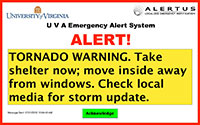If an emergency happens at the University of Virginia, how will you find out? Fire alarms, sirens, emails, text messages and notices on the U.Va. homepage are among the current roster of notification methods the University employs.
U.Va.'s Information Technology Services and the Office of Emergency Preparedness have recently added another free, useful tool: Alertus Desktop Notification. Anyone using a computer on Grounds or connected off-Grounds to the U.Va. network using a VPN connection will instantly know when a hazardous situation arises.
Marge Sidebottom, director of emergency preparedness, stressed the importance of redundant alert systems and noted that U.Va. has a broad base of notification tools.
"We're always trying to increase opportunities for appropriate messaging and reviewing our methods of notification to improve the timeliness of our alerts," Sidebottom said. "This particular program adds another layer of notification and is particularly helpful to those working on computers in a desktop environment."
In the event of an emergency, users with the Alertus program installed on their computers will receive a pop-up message that fills their entire screen mirroring messaging from UVaAlerts and emergency emails. The application functions as long as the computer is connected to the U.Va. network and is not in sleep mode. Messages sent by the system appear on the desktop and either expire after a certain time or require the user to click an "acknowledge" button.
Whenever the Alertus program is disconnected from the U.Va. network, its desktop icon turns red, indicating that alerts cannot be received and displayed.
ITS runs the server that supports Alertus and offers the program as a free download for all in the University community, including those who use both Windows and Apple computers. Go to ITS Software Central, select your operating system and then select "Alertus Desktop Alert Client" from the list of available downloads.
Many computers in the Health System already have the application installed through central distribution, according to the ITS website.
– by Preston Pezzaro
Media Contact
Article Information
August 7, 2012
/content/alertus-computer-program-enhances-emergency-awareness-uva

